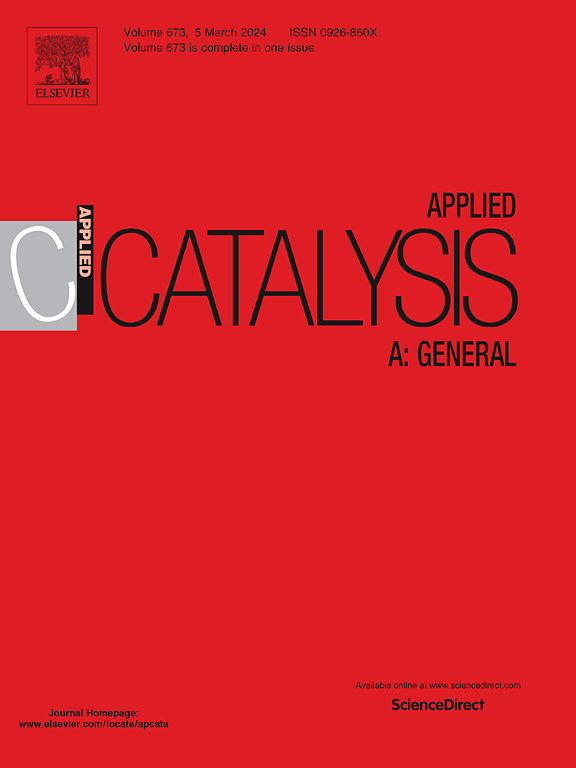Fe doping promotes water splitting activity of nickel-based catalysts in steam reforming of tar model compound
IF 4.8
2区 化学
Q2 CHEMISTRY, PHYSICAL
引用次数: 0
Abstract
Steam reforming of tar represents a cost-effective approach for tar removal in biomass gasification. Here, we developed a Ni-Fe/CeO2/CNT catalyst and unveil the effect of Fe for steam reforming of toluene (SRT) which is a representative tar model compound. The catalyst demonstrated exceptional stability (above 80 % toluene conversion, 3000 mmol/gcat/h H2 yield) over 50 h. The outstanding performance is attributed to the effect of Fe in forming Ni-Fe alloy with the highest reducibility, dispersion, Ni0 ratio, and increased sintering resistance, alongside enhanced electron transfer between Ni and Fe. Fe also promotes H2O adsorption, providing active oxygen for toluene conversion and carbon elimination. Finally, reaction mechanism was explored based on the in-situ DRIFTS and DFT calculations. DFT calculations revealed that Fe sites exhibit higher density of states, electrostatic potential, and d-band center than Ni sites, facilitating H2O coordination. Fe doping reduces energy barriers for H2O splitting and methyl dehydrogenation, while Ni promotes H2 desorption. The synergistic Ni-Fe interaction enables distinct activation of toluene and H2O, respectively. Comparative studies showed Ni/CeO2/CNT suffers from carbon deposition, while Fe/CeO2/CNT exhibits limited activity due to poor reducibility and low Fe0 content. These findings provide critical insights for designing stable Fe-based catalysts for efficient tar removal.
在焦油模型化合物蒸汽重整过程中,铁的掺杂提高了镍基催化剂的水裂解活性
蒸汽重整焦油是一种经济有效的生物质气化脱除焦油的方法。本文开发了一种Ni-Fe/CeO2/CNT催化剂,揭示了Fe在蒸汽重整甲苯(SRT)中的作用,甲苯是一种典型的焦油模型化合物。催化剂在50 h以上表现出优异的稳定性(甲苯转化率超过80 %,H2产率3000 mmol/gcat/h)。优异的性能是由于Fe在Ni-Fe合金中的作用,使其具有最高的还原性、分散性、Ni0比和烧结阻力,同时增强了Ni和Fe之间的电子转移。铁还促进水吸附,为甲苯转化和碳消除提供活性氧。最后,基于原位漂移和DFT计算,探讨了反应机理。DFT计算表明,Fe位点比Ni位点具有更高的态密度、静电势和d带中心,有利于水的配位。Fe掺杂降低了H2O分裂和甲基脱氢的能垒,而Ni则促进了H2的脱附。协同的Ni-Fe相互作用分别对甲苯和H2O具有明显的活化作用。对比研究表明,Ni/CeO2/CNT容易发生碳沉积,而Fe/CeO2/CNT由于还原性差和Fe0含量低,活性有限。这些发现为设计稳定的铁基催化剂以有效去除焦油提供了重要的见解。
本文章由计算机程序翻译,如有差异,请以英文原文为准。
求助全文
约1分钟内获得全文
求助全文
来源期刊

Applied Catalysis A: General
化学-环境科学
CiteScore
9.00
自引率
5.50%
发文量
415
审稿时长
24 days
期刊介绍:
Applied Catalysis A: General publishes original papers on all aspects of catalysis of basic and practical interest to chemical scientists in both industrial and academic fields, with an emphasis onnew understanding of catalysts and catalytic reactions, new catalytic materials, new techniques, and new processes, especially those that have potential practical implications.
Papers that report results of a thorough study or optimization of systems or processes that are well understood, widely studied, or minor variations of known ones are discouraged. Authors should include statements in a separate section "Justification for Publication" of how the manuscript fits the scope of the journal in the cover letter to the editors. Submissions without such justification will be rejected without review.
 求助内容:
求助内容: 应助结果提醒方式:
应助结果提醒方式:


